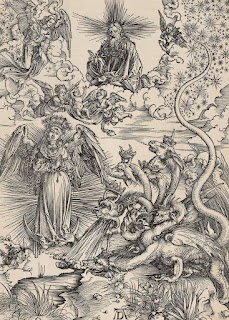Blog entry #5: Telling the Story of the Renaissance in the North: 5.7
Albrecht Durer's career was a wood engraver. Durer was born in Nuremburg, Germany and he was
the son of a goldsmith...Durer was a born in Nuremberg, the son of a goldsmith, Even as a child he
showed remarkable skill in drawing. His father apprenticed him to wood engraver" (Chapter 14, Pg.
336). Durer was imagining a new way of art where he can bring wood and paper together..."Woodcut
engravings are produced by designing on a block of soft wood, then cutting away the surrounding
wood to leave the lines of the drawing standing in relief. The blocks of the wood can then be coated
with ink and print an impression on paper" (Chapter 14, Pg. 336). This explains that unlike the other
artists where they only use paper to paint art, stone to create sculpture, or glass to fabricate images,
Durer used two materials wood and paper to design his art, which introduced a new technique to make
art. Not only Albrecht Durer was a talented artist, but he was a printmaker, theorist and a
mathematician too (Hyperlink). His art showed a gothic flavor and details on it.
Another interesting thing about Albrecht Durer was his goal, his goal was not to show the beauty of
art, but instruction about the truths of religion and effects of nature for his people, other people and
followers..."His goal was not so much in creation of beauty as it was instruction. He hoped to teach his
citizens of Nuremburg the truths of religion and the wonderful effects of nature"(Stites, Raymond S.
“Albrecht Dürer.” Art Education, vol. 17, no. 9, 1964, pp. 13–15. JSTOR, www.jstor.org/stable/3190468.
Accessed 16 Oct. 2020). Other artists during his time focused on showing beauty of their art, however
Durer on the other hand wanted to teach lessons or show a story behind his art, which made him so
significant. Durer was famous for creating arts like the "The Apocalypse", "The Passion of Christ",
"The life of Mary" and "The Nativity"..."In attempt to broadcast his art to the widest audience, Durer
engraved and printed four series of woodcuts illustrating the "The Apocalypse", "Passion of Christ" (in
two sizes), "The Life of Mary" and the "The Nativity" (Stites, Raymond S. “Albrecht Dürer.” Art
Education, vol. 17, no. 9, 1964, pp. 13–15. JSTOR, www.jstor.org/stable/3190468. Accessed 16 Oct.
2020). The significance that these art brought was it showed the talent of Durer's landscaping skills, the
amount of detail he put into the figures of the painting. For example, the hands and faces of the figures
he presented in the art just shows how well he can draw.
Furthermore, after Durer traveled all around Germany and the Netherlands he set foot on Italy, a
place full of artistry and a home full of famous artists like Leonardo Da Vinci, Raphael, Michelangelo
and Donatello... "In the Northern countries it was stated that when Durer first entered Italy, the
beginning of the Renaissance started"(JOHNSON, UNA E. “PRINTS BY ALBRECHT DÜRER.” Brooklyn
Museum Bulletin, vol. 16, no. 3, 1955, pp. 1–6. JSTOR, www.jstor.org/stable/26458399. Accessed 16 Oct.
2020). After Durer's trip to Italy, he went back to Germany with so many ideas as a result he started
working persistently for 10 years and it was at this moment he made so many engravings after he
visited the museum of art back in Italy. Actually, most of the art he created during those 10 years was
actually influenced by Italian art ideas, but he used his wood engraving skills to make a wood
engraved version of all the original arts that were in the Museum of Italy.




Comments
Post a Comment